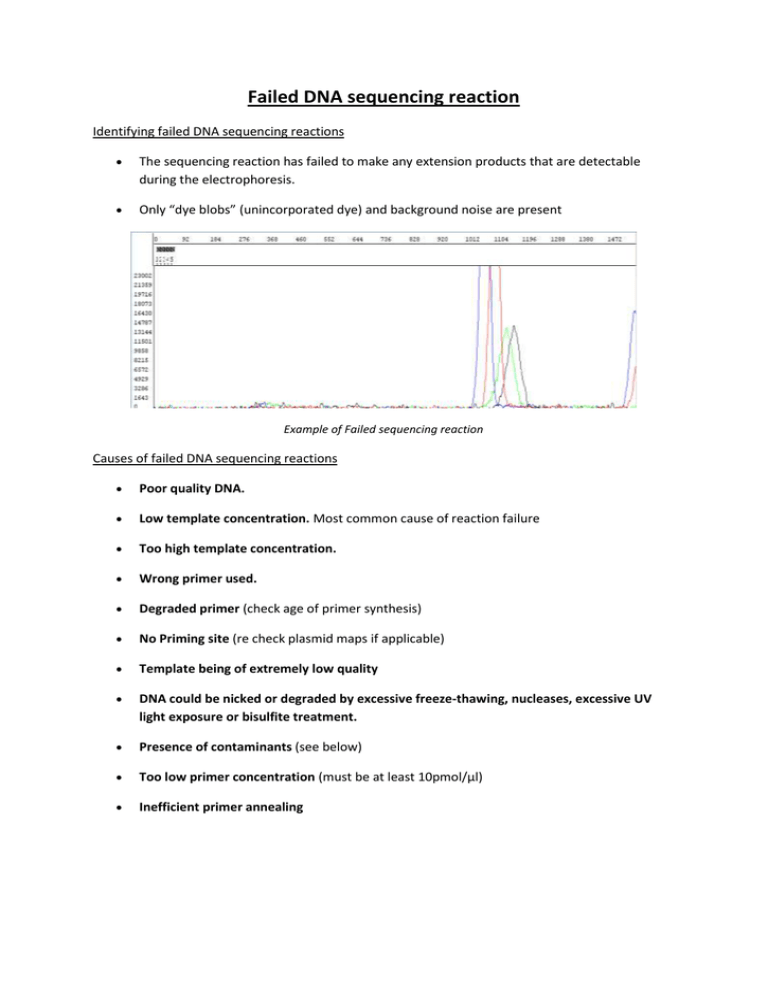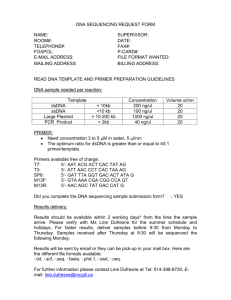Failed DNA sequencing reaction
advertisement

Failed DNA sequencing reaction Identifying failed DNA sequencing reactions The sequencing reaction has failed to make any extension products that are detectable during the electrophoresis. Only “dye blobs” (unincorporated dye) and background noise are present Example of Failed sequencing reaction Causes of failed DNA sequencing reactions Poor quality DNA. Low template concentration. Most common cause of reaction failure Too high template concentration. Wrong primer used. Degraded primer (check age of primer synthesis) No Priming site (re check plasmid maps if applicable) Template being of extremely low quality DNA could be nicked or degraded by excessive freeze-thawing, nucleases, excessive UV light exposure or bisulfite treatment. Presence of contaminants (see below) Too low primer concentration (must be at least 10pmol/µl) Inefficient primer annealing Solving DNA sequencing reaction failures Poor quality DNA. It is recommended that a plasmid miniprep kit is used. One tip is to perform a final ethanol precipitation on the kit purified plasmid DNA. This often solves problems with the quality of the template. Too much template DNA was used. This can be avoided by either checking the concentration of the template on an agarose gel before sequencing or more conveniently quantitating your DNA using the Nandrop that is located in D95 and free to use. These two options will also allow you to see the purity of the template DNA and if there is a significant amount of contaminating genomic DNA or RNA present. Do not rely on a spectrophotometer reading to calculate the template concentration. Wrong primer. This is simple to solve, but can be difficult to detect. Check the sequence of the primer and template to make sure that the primer binding site is present. This can be a particular problem with some "universal" forward and reverse primer sequences which do not work with some common plasmids. Degraded primer. Don't use old diluted primer stocks. If you have any doubt about the primer quality, make up a fresh working solution from the primer stock. Actions Check template & primer concentrations Re-prep DNA or Ethanol precipitation to remove contaminant(s) Double-check your plasmid maps/sequences. Choose another primer—be sure to use a primer design program If you’ve designed your own custom primer from previous sequence data, make sure you were using a reliable area of sequence - look for sharp, well-defined peaks with no ambiguity. Avoid areas where the peaks are broader and not well separated. Request alternative sequencing programmes (e.g. new annealing temperature) Additional Info There are many variables associated with DNA sequencing that can affect data quality. Inadequate template concentration. (The most common reason) On one hand, templates that are too low in concentration will all generate sequences low in signal intensity. When signal intensity is low the analysis software has difficulty in resolving the base peaks from background noise hence poor data quality. On the other hand, highly concentrated plasmid preparation can have a highly detrimental effect on the electrophoresis of sequencing reaction product. They cause the capillary to become blocked, inhibiting the current and causing the reaction product to pass through the capillary slower than normal. Detection of these products begins later, resulting in poor results “Dirty” templates, contain impurities which can inhibit the Taq polymerase activity or/and prevent the electrophoresis to be performed successfully. Common contaminants are: Salts (EDTA,NaCl,NaAc,Kac,KCl), High salts inhibit enzyme Note: For sequencing, DNA should NOT be dissolved in TE buffer because of EDTA's ability to bind Mg++ which is critical to Taq polymerase activity. Phenol quenches fluorescent dyes also proteins, detergents (SDS,Triton X-100), RNA, chromosomal DNA, organic chemicals (ethanol, chloroform, phenol), divalent cations (Mg,Ca,Mn), ,excess PCR primers, dNTPs, enzyme, and buffer components from PCR Error in primer concentration. Primer concentration should be at least 10pmol/ul Primer quality: Primers should have most of the following characteristics to be able to produce good, consistent sequencing data. 1. High purity 2. No mismatches 3. No potential alternative binding site in the template 4. No secondary structures present, especially at the 3' end 5. 1-8 bases minimum, longer for AT rich primers 6. Avoid runs of more than 4 of the same bases 7. Tm adapted to our annealing temperature (50°C) Our primer/template annealing step occurs at 50ºC. Thus, if your primer Tm is much lower than 50ºC, hybridization to its complementary template will be much less efficient and a lesser number of extending fragments will be generated. Increase your primer Tm by adding additional bases to the 5’ or 3’ end to raise the Tm to be within the range of 52ºC-58ºC. Degenerate primers and those with mismatched bases will also show decreased hybridization efficiency due to reduction of the stability of primer binding, and if degeneracy or mismatches occur at or near the 3’ end of your primer, it is highly likely that your sequencing attempt will fail. Difficult DNA content: If your DNA template failed to give good sequence data with the standard BigDye Terminator chemistry and the failure is not due to the poor template/primer quality, incorrect quantity or other improper sample preparation steps, then the DNA may be a Difficult Template AT or GC rich sequences Secondary Structure Repeats Homopolymer regions Cosmids, P1 clones No SINGLE chemistry will work on all templates, be prepared to use other possible sequencing chemistries although the Big DYE TERMINTOR V3.1 does a good job on most templates.




